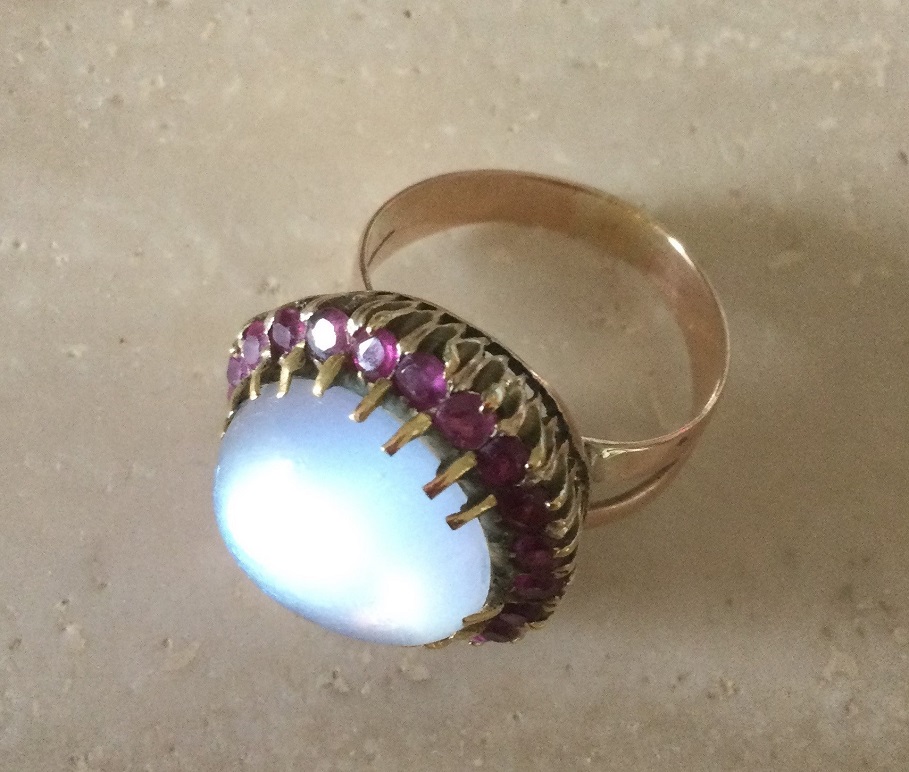A Journey in India, part 1
by Robyn McWilliam
My grandfather sold Rolls Royce cars to the maharajahs in India. With his wife, Flora, they went to live in what was then Bombay in 1919. This story awakened a desire to travel to this country. A treasured memento, my moonstone ring, came from my grandmother. This half orb of milky luminescence surrounded by pinkish rubies was originally a pendant. I had it melded with her wide-band wedding ring. Intricate gold filigree holds the stones in place.

my grandmother's moonstone ring
In October 2019, a century after my ancestors, I travel to India. Wendy, my best friend, and her husband, Malcolm accompanied me. As soon as I booked, she said, ‘We’re coming too. My English mother was born in Darjeeling.’ This trip was before Covid 19 delayed or destroyed our ability to venture overseas.
This colourful nation of over 1.35 billion people is one of great inequities of wealth. Many a friend told me they couldn’t handle seeing the poverty. But I’d had some preparation years earlier reading Sarah Macdonald’s book, Holy Cow! She explained the inhabitants were trained to look down. There’s always someone worse off. This is why Indians don’t present as a race of miserable people.
Our first stop is the state of Kerala in the south, home to 33 million people. Kochi, its commercial capital, faces the Arabian sea. Of its two million residents nineteen per cent are Muslims, twenty-four per cent are Christians and the rest Hindu. The language spoken is Hindi.
Traffic chaos is immediate as our coach dodges pot holes and scrawny wandering cows. Buses are decorated with garlands of flowers: red, orange and white. Electrical wiring, like tangled strands of spaghetti, hangs along the streets. Horns honk constantly as bicycles, motorbikes, scooters, small cars and tuk tuks weave along the road missing each other by millimetres. We’re told salaries are good here, attracting people from other parts of the country.
Spaghetti wiring in the streets
Dodging a cow
We arrive at our haven of luxury, the Le Meridien Hotel. Our first excursion is to the river to watch fishing with huge nets attached to poles. After some time submerged, fishermen pull on ropes weighted with rocks. Fish flutter in the raised nets and are gathered to sell. The structures remind me of Egyptian shadoofs used to retrieve water.
Unusual fishing nets
A stall for the catch
Then it’s off to the Ginger House for lunch. In the gardens we walk past an old timber cart laden with pot plants at precarious angles. A sculpture of Shiva in the classic dancing pose, with an extra pair of arms entices me to take a photo.
Restaurants' garden
Cart full of plants
Inside we are served a prawn curry and kingfish followed by ginger ice cream. My first exotic flavours of India!
Shiva dancing - Nataraja, also known as Adalvallan, is a depiction of the Hindu god Shiva as the divine cosmic dancer. His dance is called the 'tandava'. The pose and artwork are described in many Hindu texts such as the Tevaram and Thiruvasagam in Tamil and the Amshumadagama and Uttarakamika agama in Sanskrit and the Grantha texts. The dance murti featured in all major Hindu temples of Shaivism, and is a well-known sculptural symbol in India and popularly used as a symbol of Indian culture, as one of the finest illustrations of Hindu art.
Photos by Robyn McWilliam